#Portugal 1809
Text
Petiet about the death of Alfred de Lameth
I still owe @cadmusfly a translation of this passage in Petiet’s memoirs. And I had totally forgotten about it. Mea culpa! Also, please bear with me, it’s rather long. But also quite gripping.
The Duke of Dalmatia had made General Quesnel governor of Oporto.
Sidenote: That’s one of the guys whom Gotteri suspects to have been in on the Argenton conspiracy.
The auditor Taboureau was intendant and Captain de la Colombière, in the service of Spain and the marshal's interpreter, had just been appointed by him as Spanish consul in this city.
And if this post wasn’t too long already, I would love to comment on the ways Soult apparently set up his makeshift administration:
Colombière, aren’t you basically a Spaniard? Excellent, consider yourself transfered to diplomatic service as the new Spanish consul.
La Colombière: Uhm… and what are my duties as consul of Spain?
Chorus of ADCs chanting in the background: Par-ty, par-ty, par...
On 11 April, the day of his inauguration, Monsieur de la Colombière gave a dinner for the army's general staff. General Ricard, chief of staff, attended, as did the aides-de-camp and officers of the Duke of Dalmatia.
Notably missing: The Duke of Dalmatia. Which makes me wonder if this wasn’t another Go get drunk elsewhere! incident...
Captain Choiseul-Beaupré, Franceschi's aide-de-camp, and Alfred Lameth, who were due to leave the next day to see this general, were present at the party, which was very merry and lasted until four in the morning. Eugène Choiseul, […]
That’s a different member of this illustrious family, and another of Soult’s aides.
[…] addressing his cousin and Lameth, told them that the route they were about to take was safe and that he had just taken it alone and without a guide. Lameth observed that in Portugal a road was only safe up to the moment at which no one had yet been murdered on it. The disastrous event which took place on the 13th proved only too well the truth of his answer.
And of course, knowing this, the most professionel approach is to start the trip worn out, without sleep and drunk as a skunk. But at least they're finally on their way and I can refrain from any further comments.
Choiseul-Beaupré and Lameth, tired from the night they had spent with the new Spanish consul, instead of going to Franceschi's headquarters the same day, stopped at Villa de Feira, four leagues from Oporto. A convoy of clothing, escorted by dragoons, had just arrived there. The next day, the 13th, the two officers preceded the convoy, which was moving slowly, and they asked to be followed by two dragoons. They had just passed the village of Arrifana when they entered a sunken road, the narrowness of which meant that they had to march one at a time, in this order: one dragoon, Lameth, Choiseul and the second dragoon.
In the middle of the sunken road was a path that turned right and led to a village in the fields. The continuation of the road, making a slight bend to the left, led to Oliveira, one of the cantonments of General Franceschi's troops. The hills bordering the sunken road were covered in woods where fifty or so armed peasants had taken cover, no doubt waiting for the convoy. The leading dragon followed the road directly, but as Lameth took the path to the right, Choiseul shouted at him: "Lameth, you're going the wrong way!" Immediately, a shower of musketry killed Alfred de Lameth and Choiseul's horse. The second dragoon fled towards Arrifana, while the first abandoned his horse and ran towards Oliveira amid renewed shooting and a hail of stones thrown at him by the insurgents from the top of the hill.
Choiseul had his foot caught under his horse. As he tried to remove it, he was hit by a bullet that slightly injured his ear. Choiseul redoubled his efforts, managed to free his leg, got to his feet, ran across the land to the left of the road in the direction of Oliveira and crossed a river at the foot of a hamlet. The armed peasants then ran down the hill like a torrent and followed in his footsteps. Choiseul only had time to reach the first house in the hamlet and ask an old man to save him.
The insurgents entered the cottage, seized Choiseul and took his watch and money. Soon there was a quarrel between the brigands over the division of the spoils and Choiseul, who noticed the compassionate eyes of the old man, hoped that the discussion between his attackers might save his life. But he was taken to a plain near the cottage to be shot. He saw a large number of inhabitants of both sexes gathered there. Choiseul shouted to them in their language that he did not recognise Portuguese honesty in the conduct of those who wanted to immolate a defenceless man. He added that, according to the laws of war, he should regard himself as their prisoner and not their victim. He ended by telling the inhabitants that if his blood were spilt, they would have to fear the most terrible vengeance.
The Portuguese, astonished to hear a Frenchman explain himself in their idiom with as much ease as energy, stopped, grouped together, talked amongst themselves and soon beckoned Choiseul to follow them. They returned to the house where he had been arrested. The old man wants to give him back his purse and his watch. The money is found but the watch has disappeared. The old man says to Choiseul: "You have not been arrested by soldiers of our nation, but by highway robbers. We are going to give you six of us to take you to your people. You should not even consider yourself a prisoner."
However, the first dragoon arrived breathless at Oliveira and told General Debelle, who was in command there, that chef d'escadron Lameth had just been murdered and that Captain Choiseul was in the greatest danger. Tholozé, aide-de-camp to the marshal, […]
Yes. Another one. Brun’s Cahiers have a report by him about what happened during the evacuation of Oporto, when Wellesley attacked.
[…] was returning to Oporto and was close to the general. He assembled a detachment of dragoons and galloped towards the scene of this deplorable event. The six peasants escorting Choiseul saw the French arrive at full speed. They paled and thought they had arrived at their final hour. Choiseul reassured them, ran to meet Tholozé and shouted at him to spare his liberators. Lameth's body is found and he is taken away to perform the last services.
As soon as the Marshal, who was very fond of Alfred, learned of his assassination, he ordered the Thomières infantry brigade to go to Arrifana, to gather the old men, women and children in the church and to burn the village. General Thomières went to Arrifana to carry out this fatal mission. The village leaders came to meet the General and told him that the fifty culprits, strangers to Arrifana, had been arrested and would be handed over to him. General Thomières then took it upon himself to change the order he had received. The village was respected and the fifty brigands were hanged in front of the church.
So, according to Petiet, the village was not burned in the end. That’s somewhat in accordance with Soult’s memoirs, who claims to only have ordered to find and execute the murderers und to have their houses burned. Petiet, however, was sent on another mission the day after Lameth had left Oporto and can only have learned of all these events later, most likely from the ADC Choiseul, with whom he was close friends, as he states in his memoirs.
There you have my very belated translation. Sorry for the delay 😥.
20 notes
·
View notes
Photo
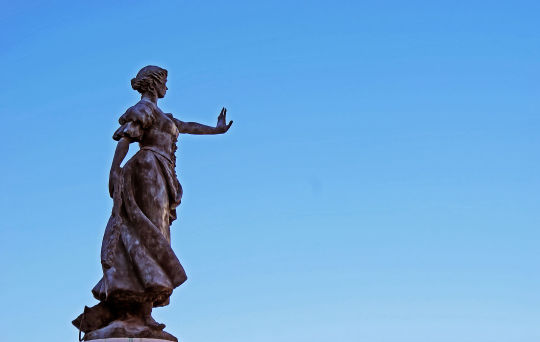
(Photo: Carmen Escobar Carrio)
Juana Galán - Heroic guerrillera
When the French invaded Spain during the Peninsular War, some women were determined to resist. Among them was Juana Galán (1787-1812), the daughter of a prosperous tavern keeper.
On June 6, 1808, a column of 1,000 enemy troops attacked the town of Valdepeñas. Juana rallied the townswomen under her command. They manned the windows and threw boiling water and oil at the enemy.
Juana went to the street armed with a club. She reportedly pulled several French soldiers from their horses and dispatched them with a blow to the head. The townspeople’s fierce resistance forced the French to retreat and never return.
Juana didn’t live to see the end of the war. She died in 1812 while giving birth to her daughter. Her legacy lives on and she was made a local heroine and a symbol of resistance. She now has her own monument in Valdepeñas.
Like Juana, other women fought in desperate situations or during riots, sometimes with improvised weapons. In 1809, an unnamed woman armed with a sword rallied the inhabitants of Penafiel (northern Portugal) and led them in battle against the raiders. In 1811, María Marcos, a tavern keeper from La Palma del Condado, played a key role in repelling a small group of French soldiers.
There were also cases of women involved in guerrilla warfare. The Catalan Somatén, a paramilitary defense organization, had female members such as María Escoplé, Magdalena Bofill, Margarita Tona, María Catalina and Catalina Martín. Francisca de la Puerta reportedly fought in Extremadura and commissioned the Junta of her province for permission to form her own guerrilla band.
Wanting to avenge her father and brother, Martina de Ibaibarriaga Elorriagafora disguised herself as a man and led a guerrilla band until she gained a commission in the Spanish army. An unnamed woman was given the command of a troop by the Junta of Molina de Aragón in 1809. A British officer also mentioned women serving with bands of irregulars as active combatants.
For more heroines of the Peninsular War, see Agustina de Aragón.
Feel free to check out my Ko-Fi if you want to support me!
Further reading
Esdaile Charles J., Women in the Peninsular War
Sheldon Natasha, “Juana Galan: A Spanish Heroine of the Peninsula War”
#Juana Galán#history#women in history#spain#spanish history#peninsular war#napoleonic wars#19th century#women's history#warrior women#war#women warriors#historyblr#badass women#historicwomendaily#historical ladies#warriors
71 notes
·
View notes
Photo
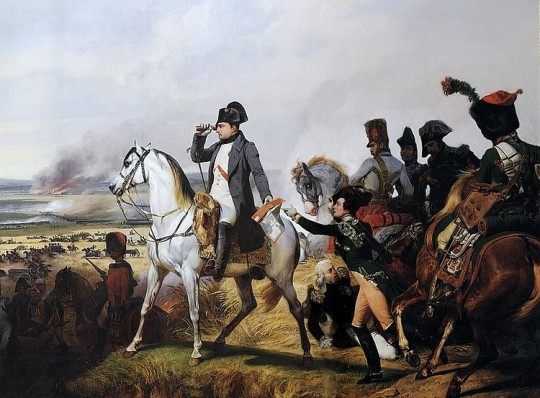
Battle of Wagram
The Battle of Wagram (5-6 July 1809) was one of the largest and bloodiest battles of the Napoleonic Wars (1803-1815). It resulted in a pyrrhic victory for French Emperor Napoleon I (r. 1804-1814; 1815) whose army crossed the Danube River to defeat Archduke Charles' Austrian army. Wagram ultimately allowed Napoleon to win the War of the Fifth Coalition (1809).
Background
Ever since its defeat at the Battle of Austerlitz (2 December 1805), the Austrian Empire itched to exact revenge upon Napoleon and recover its status as a major power in Central Europe. In the three years that followed the battle, Austria bided its time as its army was modernized by Archduke Charles, brother of the emperor and commander-in-chief of the Austrian forces. Charles' reforms included a system of mass conscription through the Landwehr militia and a reorganization of the army into nine line and two reserve corps, copying the corps d'armee system that had contributed to Napoleon's success.
By early 1809, hundreds of thousands of French soldiers were off in Iberia fighting the Peninsular War (1807-1814) against Spain and Portugal. This greatly reduced France's military presence in Germany, an opportunity that Austrian Emperor Francis I was keen to take advantage of. Francis ordered his brother to prepare for war, and on 10 April 1809, Archduke Charles sparked the War of the Fifth Coalition when he invaded France's ally of Bavaria with 200,000 men. Napoleon was prepared; having noticed the build-up of Austrian forces, the French emperor had raised a new Army of Germany that consisted mainly of French conscripts and allied German soldiers from the Confederation of the Rhine. Since Archduke Charles' invasion got off to a slow start, Napoleon was able to launch a rapid counteroffensive. In the ensuing Landshut campaign, Napoleon's Army of Germany won a string of battles and forced Archduke Charles back across the Danube. Charles' retreat left the road to Vienna wide open, and Napoleon occupied the Austrian capital on 13 May.
Emperor Francis had evacuated Vienna before the French occupation, and Archduke Charles had rallied his forces and was currently sitting on the opposite bank of the Danube. Since all the major bridges across the river had been destroyed, Napoleon needed to build his own. He chose the floodplain of Lobau Island, south of Vienna, as the ideal location for his river crossing. By midday on 20 May, the pontoon bridge was completed, and the first elements of the French army crossed over to occupy the towns of Aspern and Essling. By the next morning, Napoleon had gotten 25,000 troops across the river, but efforts to get the rest of his army across were frustrated by the Austrians, who floated flaming barges down the river to punch holes in the French bridge.
At 1 p.m. on 21 May, Archduke Charles ordered an attack. The French were surprised by the sudden Austrian assault, and brutal fighting erupted around Aspern and Essling that lasted well into the night, at which point the French retained control of both towns. The battle resumed on the morning of 22 May; while the Austrian wings were embroiled in the struggle for the towns, French Marshal Jean Lannes led a charge against the vulnerable Austrian center. His attack came close to success but was stopped by the personal intervention of Archduke Charles, who led a spirited counterattack. As the day wore on, the French were pushed out of Essling, and the bridge was repeatedly damaged, preventing Napoleon from getting the rest of his army across. At 3 p.m., the French emperor decided to cut his losses and ordered a withdrawal to Lobau. The Battle of Aspern-Essling marked Napoleon's first major defeat in a decade and had cost him between 20-23,000 casualties including the irreplaceable Marshal Lannes, who was mortally wounded. The Austrians also suffered around 23,000 casualties but achieved victory, having denied the river crossing to Napoleon.
Continue reading...
21 notes
·
View notes
Photo



A fine Lloyd's Patriotic Fund sword of £50 value to Lieutenant
Wm. Howe Mulcaster Of H.M.S. Minerva, dated 15 July 1805
William Howe Mulcaster, a nephew of General Sir Samuel Auchmuty, was born in 1785 and entred the Navy at the age of fifteen. On the 22nd June, 1805, whilst serving as first Lieutenant on the 32-guns frigate Minerva, which was becalmed in Finisterre Bay, he was dispatched in command of two boats to investigate some Spanish luggers laying on the coast. The luggers were moored by a fort which mounted both 12 and 24 pounder guns but was quickly taken without loss. After spiking the guns, the five luggers, all laden with wine, were brought out the following morning, again without losses in spite of the fact that they were fired upon for nearly two hours by a two-gun battery just south of the town. It was for this action that he received this sword.
In 1809 he served with Captain Yeo on H.M.S. Confiance at the capture of Cayenne for which he received a sword from the Prince Regent of Portugal and was promoted to Commander. He also served with Yeo on the Great Lakes in the War of 1812. He commanded the sloop Royal George in 1813 in several actions on Lake Ontario and in 1814 he led a landing party of 200 men armed with boarding pikes in the Raid on Fort Oswego. He was severly wounded by grapeshot resulting in the loss of his leg. This ended his active career, for which he was awarded a pension of £300 and nominated a Companion of the Order of the Bath. In 1831 he was knighted and became aide-de-camp to King William IV. He died in 1837
121 notes
·
View notes
Photo
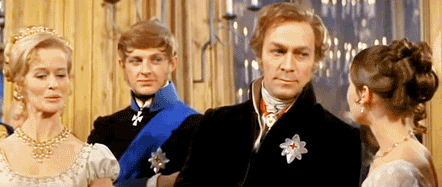
The English certainly and fiercely pride themselves in never praising themselves.
- Wyndham Lewis,
In the Spring of 1814 Europe was, for the first time in living memory, not at war. The Emperor Napoleon was in exile and the Bourbon king, Louis XVIII was back on the throne of France. Wellington had, from 1809 to the termination of the Peninsular War in both Spain, Portugal and Southern France, defeated every Marshal of France that Napoleon had sent against him. Each of these great warriors; Massena, Victor, Ney, Jourdan, Marmont and Soult entered the Iberian Peninsula with past honours heaped upon them by their Emperor, Napoleon. Each returned with their military reputations in tatters. All beaten by Wellington.
It was therefore expected that they would give a somewhat cool reception to the Duke of Wellington when Louis XVIII invited him as guest of honour to a Ball in Paris. When Wellington arrived the Marshals of France whom he had so resoundingly beaten in previous campaigns turned their backs on him. A blushing Bourbon king apologised for their rudeness but the Great Duke just shrugged his shoulders and said ” Tis of no matter your Highness, I have seen their backs before!”
#wyndam lewis#quote#the english#wellington#duke of wellington#napoleonic war#england#france#war#history#character#louis XVIII#marshals of france#french army#british army#europe
69 notes
·
View notes
Text

Officer's Sword of the 3rd Foot Guards of the British Empire dated to 1809 on display at the Holburne Museum in Bath, England
This sword belonged to Captain Francis Holburne (1788 - 1814) who joined the 3rd Foot Guards in 1806 to fight in the Peninsular Campaign in Spain and Portugal. Francis was the older brother of William Holburne created the collection now housed in the Holburne Museum.
Francis suffered fatal wounds at the battle of Bayonne in 1814. As he lay dying he apparently specified that his sword and sash be sent to his brother. The battle took place after the abdication of the Emperor Napoleon and so was largely unecessary.
Photographs taken by myself 2023
#sword#art#19th century#military history#napoleonic wars#british empire#england#english#georgian#holburne museum#bath#barbucomedie
6 notes
·
View notes
Text




IMAGENES Y DATOS INTERESANTES DEL DIA 22 DE ABRIL DE 2024
Día Internacional de la Madre Tierra, Día Mundial de las Tiendas de Discos, Semana Mundial de la Creatividad y la Innovación, Semana Europea de la Inmunización, Semana de Vacunación en las Américas, Año Internacional de los Camélidos.
Casandra, San Cayo, Santa Oportuna y Santa Elimena.
Tal día como hoy en el año 2011
En Siria, este viernes, cientos de miles de manifestantes vuelven a salir a la calle para exigir el fin de la dictadura. La policía y los matones del régimen disparan sobre las multitudes desarmadas y dejan un saldo de más de 80 muertos. De esta manera, el presidente Bachar el Asad demuestra que está dispuesto a ahogar en sangre y fuego la revuelta de su pueblo. La opción de un vuelco político relativamente incruento, como en Túnez o Egipto, se antoja inconcebible, y en diciembre, después de que la Liga Árabe decrete sanciones al régimen, el gobierno acentuará la represión. (Hace 13 años)
1915
En Cuba se inaugura el Teatro Nacional de la Habana, con la ópera "Aida" de Verdi, por la compañía de Adolfo Bracale. (Hace 109 años)
1915
Las fuerzas alemanas sorprenden a los aliados en Ypres (Bélgica) al usar por primera vez gas de cloro (chlorine gas) en el campo de batalla, causando al menos 5.000 bajas y contaminando las trincheras enemigas. Los alemanes utilizan máscaras de gas y uniformes protectores muy sofisticados. La respuesta de los ingleses con el mismo agente químico se dará seis meses más tarde en Loos (Francia). En 1917, los alemanes usarán el gas mostaza y el fosgeno en Verdún. El terrible balance al final de la I Guerra Mundial será que una cuarta parte de los proyectiles habrá contenido agentes químicos, que más de 100.000 personas habrán muerto y hasta 1.000.000 habrán resultado heridas por el uso de gases durante esta trágica contienda. (Hace 109 años)
1912
En Rusia se publica el diario Pravda, periódico de los comunistas bolcheviques, que más adelante se convertirá en el órgano oficial del Partido Comunista de la URSS. (Hace 112 años)
1898
En La Habana (Cuba), veinte buques estadounidenses, al mando del contralmirante William T. Sampson, bloquean la bahía, primer acto de guerra de Estados Unidos contra España. El bloqueo, que durará tres meses, provocará desabastecimiento de víveres a la ciudad por vía marítima, y la declaración de guerra de España a Estados Unidos dos días después. (Hace 126 años)
1809
Desembarca en Lisboa (Portugal) Sir Arthur Wellesley, que apoyado por los portugueses expulsará a los franceses de Portugal. Entrará en España por el valle del Tajo y en Talavera derrotará en junio a las tropas francesas. Más tarde será nombrado Duque de Wellington y generalísimo del ejército español. Logrará la expulsión de los franceses a Francia en la batalla de Vitoria de 1813, y será la bestia negra de Napoleón por los campos de Europa, hasta lograr su detención en la batalla de Waterloo. Sir Arthur Wellesley será un gran general pero un pésimo político. (Hace 215 años)
1529
Mediante el Tratado de Zaragoza, Carlos I, rey de España, vende a la Corona de Portugal "todo derecho, acción, dominio, propiedad, posesión o casi posesión y de todo derecho a navegar, contratar y comerciar en el Maluco (islas Molucas), por 350.000 ducados de oro, de 375 maravedises cada uno". Ha favorecido mucho a esta decisión el matrimonio, tres años antes, de Carlos I con la princesa Isabel de Portugal. Este Tratado delimitará exactamente las zonas de influencia portuguesa y española en Asia, ya que las islas Filipinas siguen en poder de España. (Hace 495 años)
1500
El navegante y explorador portugués Pedro Álvares Cabral, que sigue la ruta marítima del viaje de Vasco de Gama a la India, divisa tierras sudamericanas, cerca de donde se encuentra la actual ciudad de Porto Seguro, Brasil, y toma posesión de todo el territorio noroeste brasileño en nombre de la Corona de Portugal y, a la nueva tierra descubierta, le otorga el nombre de "Tierra de Santa Cruz". (Hace 524 años)
1370
Hugues Aubriot, preboste de los mercaderes de París, Francia, coloca la primera piedra de lo que será la Bastilla, fortaleza que se convertirá en símbolo del despotismo real ya que, con el pasar del tiempo, su función defensiva se irá diluyendo hasta convertirse en prisión estatal. (Hace 654 años)
3 notes
·
View notes
Text
Tiled Churches, Cais de Ribeira, & Crystal Palace Gardens - Porto, Portugal
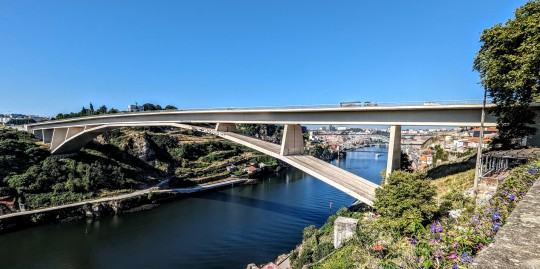
Our first full day in Porto! We walked down to an overlook - getting our first view of the Douro River and the Ponte de Infante. We were not disappointed! From there we walked back toward the city, in search of a few of the tiled churches.
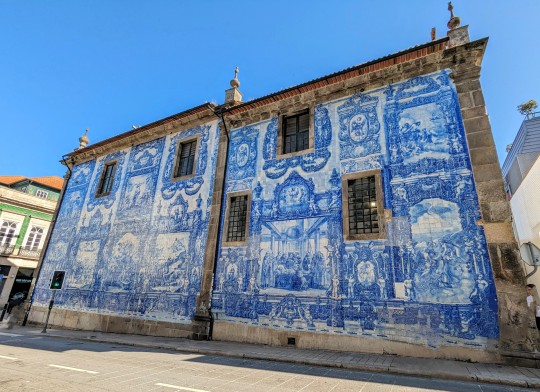
Chapel of Souls and/or Chapel of Santa Catarina - built in the 18th century. The tile facade was put in place in 1929.
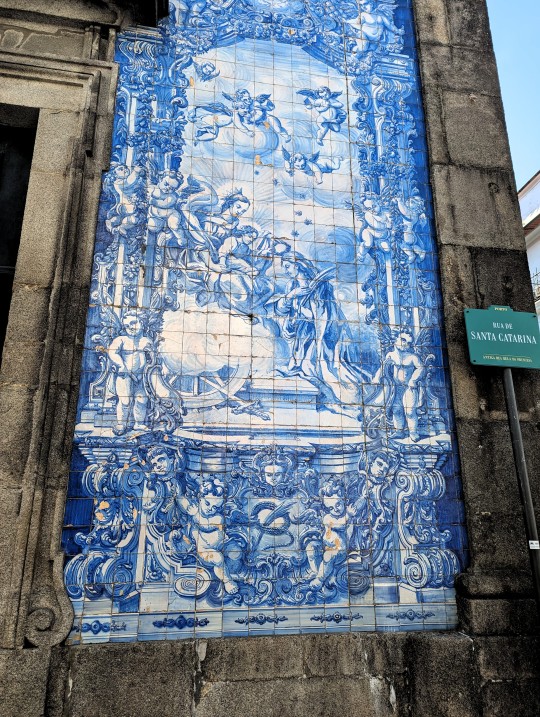
Close-up of one of the tile panels.

Church of St. Ildefonso, the next stop on our walk.
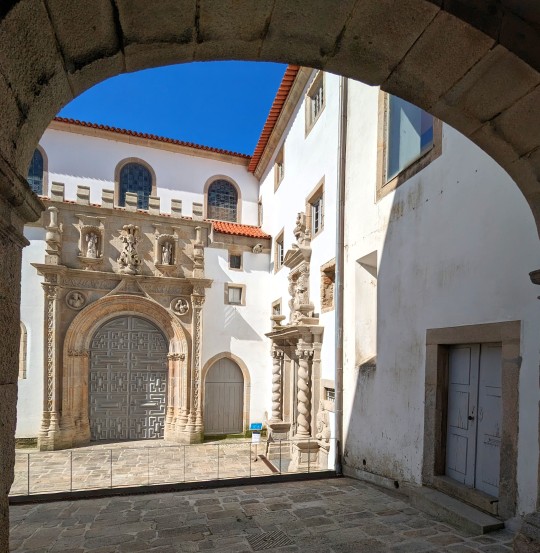
Church of Santa Clara - a 15th century church.

Our first descent down to the Douro River - the Luis I Bridge in the distance.
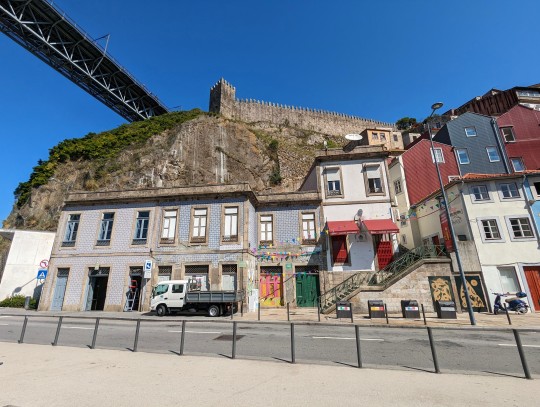
Looking back up at the Fernadine Walls of Porto from the walkway next to the river - so steep!

The beautiful Cais de Ribeira with Ponte Luis I in the distance.
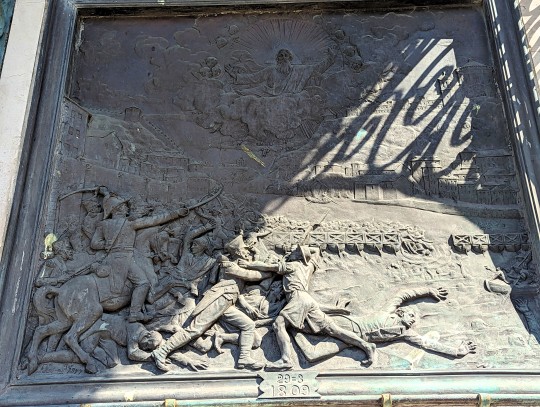
Bronze plaque along Cais de Ribeira memorializing the people who died in the Ponte de Barcas tragedy. The bridge collapsed under the weight of the people fleeing the French troops in 1809.

Postigo do Carvao - the only remaining one of the 18 doors and hatches built into this wall that connected the harbor pier to Fonte Tarina street, dating back to 1386.
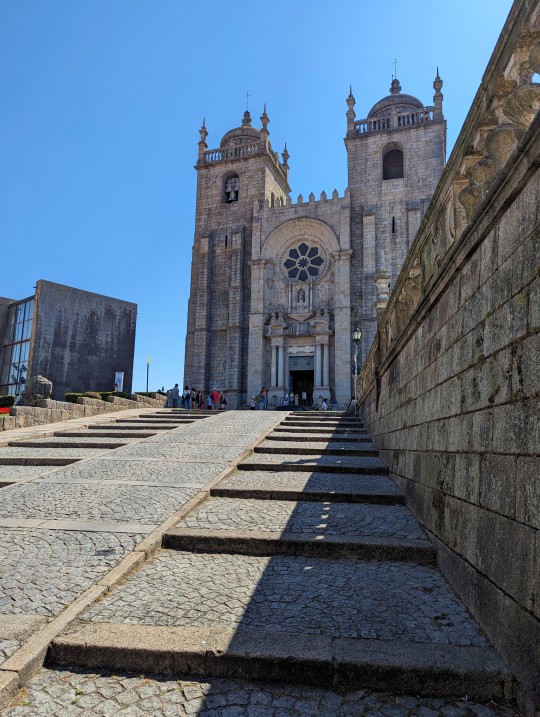
Unfortunately, we had to climb back up from the river to continue our exploration. This is Porto Cathedral, just a few more steps and we were there!
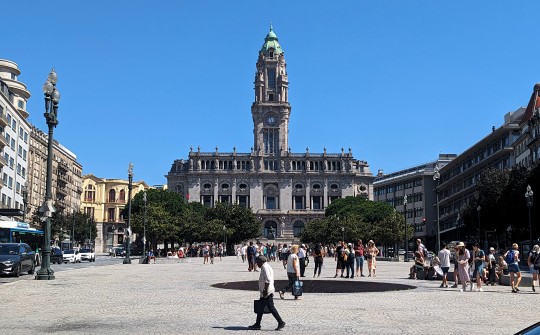
View of Camara Municipal do Porto (town hall), as we crossed the plaza on our walk.

Igreja do Carmo - another one of the beautiful tiled churches that we passed on our walk over to the Crystal Palace Gardens.
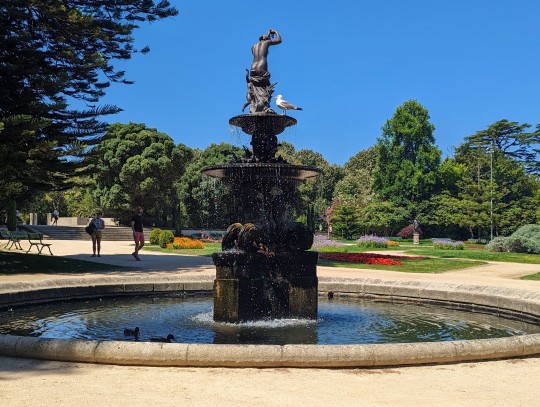
We arrived at the beautiful Crystal Palace Gardens, we found a nice bench in the shade to sit and relax for a few minutes.

One of the multiple peacocks and peahens wandering around the gardens.

Fantastic view of the Douro River from one of the overlooks in the Crystal Palace Gardens. We walked a bit more along the upper section of the gardens, before deciding that we were ready to head back to our place.

Our path back to our Airbnb took us right next to Sao Bento Train Station, we dipped in for a quick picture - a very impressive interior! Gorgeously decorated with tiles, definitely worth the few extra steps.

Somehow, we managed to have to climb one last set of stairs to get back to our place! However, the view and the vibrant colors from the top were picture-worthy, plus I needed to take a moment to catch my breath once we got to the top!

Wonderful first day in Porto!
2 notes
·
View notes
Photo

On or around 19th February 1792 Arthur Anderson was born at Böd of Gremista, Lerwick.
Having recognised his son was intelligent, and having a great regard for education Arthur was sent to a small elementary school set up by the Rev John Turnbull. However, aged 12, He had to leave school to earn some money. He was employed by Thomas Bolt of Bressay, a fish-curer and general merchant. Arthur was given the job of beachboy, cleaning fish, then spreading them, when salted, on the beach. However, Bolt soon recognised Arthur’s intelligence, and put him to work in his office, where he acquired useful business habits. He also continued to see the Rev Turnbull, who further satisfied his urge to learn.
By the time Arthur was 15, Britain was at war with France, and British navy ships frequently visited Shetland looking for “recruits”. The Press Gang forcibly removed young men to enrol in the Navy, and in 1807 Arthur was frogmarched to a boat waiting to take him to the Navy ship offshore. Fortunately, Bolt’s guarantee that Arthur would join up at 16 saved him, and the following year Arthur found a berth on a visiting warship bound for Portsmouth, and the Royal Navy.
By 1809 he was midshipman on board the 64-gunner HMS Ardent, but soon realised that expenses as an officer required more money than he possessed, so in 1810 he transferred to the smaller HMS Bermuda . There he served five years as captain’s clerk , reading avidly and becoming fluent in Spanish and Portuguese. He left in 1815, one of 3000 Shetlanders who served in the Navy during the Napoleonic Wars.
Seeking work in London, Arthur’s uncle, Peter Ridland, introduced him to Brodie Willcox, a young man starting out as a ship-broker. Employed at first in Willcox’s office as a clerk, the company’s connections with Spain and Portugal meant he soon became invaluable, and in 1822 joined Willcox as a partner in a firm of ship charterers. That same year he married Mary Ann Hill, daughter of a shipowner.
The new firm proved successful, and soon acquired its own ship, later fitted out with guns and used for Portuguese trade. During subsequent civil wars in Spain and Portugal, the company supported the royalists, including shipment of arms and extra vessels – a sound decision, resulting in contracts with both countries to deliver mail, and entitlement to fly a flag embodying the colours of Spain and Portugal.
Despite traditionalists’ misgivings, they began increasingly to use steamships, forming the Peninsular Steam Navigation Company, then in 1840 the Peninsular & Oriental Steam Navigation Company– the beginning of P&O, with Anderson and Willcox directors. While Willcox ran the company in London, Anderson travelled widely, problem-solving. Within ten years, they sailed to India and the Far East, owning property in many countries, and forming an essential part of British trade. This included transportation of opium from India to China – a legal trade at that time, although not universally approved of by the British public.
Having established these regular routes for their ships, Arthur suggested a way to avoid the hazardous journey round the Cape of Good Hope would be to construct a canal between the Mediterranean and the Red Sea, via Suez. However, the British disagreed, and in 1869 France and Egypt collaborated in building the Suez Canal. Meanwhile, Arthur arranged transportation of mail and passengers overland by horse-drawn carriages, with coal for the steamships carried by 4000 camels.
During all this activity, he never forgot his birthplace His philosophy was , “Wealth ought not to be sought for its own sake, but as a means of being useful to others.” It’s a pity the now owners of P & O don’t hold the same beliefs!
In 1836 he founded Shetland’s first newspaper, The Shetland Journal, financed, edited and largely written by himself. He attacked the power wielded by lairds over crofting and fishing, as well as suggesting social improvements, and his Liberal policies proved very popular, including his petition to Parliament protesting against the invidious Corn Laws. Unfortunately, it proved too difficult to produce the paper from London, and after a few years it closed down
In an attempt to break the monopoly of the lairds, and put an end to fishing tenure, he set up the Shetland Fishery Co in 1837on the island of Vaila. He aimed to open up new markets, and provide work for men too poor to have their own boats He introduced new methods, and paid wages. Initially successful, his lease expired in the ‘40s, his health was beginning to fail, and business ceased. However, the lairds’ grip on fishing could be loosened – young men had discovered an independence not available to their parents, and meant to keep it.
In 1839 he was largely responsible for Shetland’s first steamship, enabling speedier mail services. Also, from 1847-1852 he was Liberal MP for Orkney and Shetland.
Nor did he forget the women. Shetland women knew how to knit and spin, to supplement the family income, but usually they “sold” their knitwear to local merchants in exchange for goods, not cash – the invidious Truck System. Arthur encouraged knitting of lace items for a friend’s shop in London, for payment in cash, and in 1837 he presented some fine examples to Queen Victoria. Impressed, she immediately ordered a dozen pairs of lace stockings, the court ladies followed suit and a burgeoning fine lace industry emerged.
Since his own schooldays, Arthur had an interest in the education of those unable to afford private schooling. In 1852 he employed a teacher in the Skerries, then in 1862, despite no local support whatsoever, he built the Anderson Educational Institute in Lerwick, to provide secondary education. It featured a relief sculpture of his parting with Thomas Bolt in 1808, whose advice was to become the school motto – “Dö weel an’ persevere”. This resulted in increased opportunities for Shetland youngsters, and greatly changed the structure of local society. Outwith the isles, he also set up schools in Southampton for the children of P&O employees, while in London he provided the Norwood Working Men’s Institute for social, cultural and trade union purposes.
When his beloved wife died in 1864, he fulfilled her wish of erecting the Widows’ Asylum in Lerwick, (now the Anderson Homes,) intended for the widows of Shetland fishermen and seamen. A separate fund, the Shetland Widows’ Trust, still operates today.
In 1862 Brodie Willcox died, whereupon Arthur became Chairman as well as Managing Director of P&O. However, his poor health finally proved too much, and in February 1868 he too died, aged 76 and still working.
6 notes
·
View notes
Text
Napoleon Bonaparte, one of history's most renowned military commanders, expanded French control across much of Europe during the Napoleonic Wars (1803–1815). His conquests reshaped the political landscape of the continent. Here’s a list of significant cities and countries he conquered, with details on how and when they came under his control:
### 1. **Italy (1796–1797)**
- **Cities**: Milan, Venice, Turin, Genoa, Rome
- **Details**: Napoleon’s first major campaign was in Italy, where he defeated the Austrian forces and their allies. He reorganized the region into several French-controlled republics: the Cisalpine Republic (around Milan) and the Ligurian Republic (around Genoa). Venice was handed over to Austria in 1797 but later annexed by Napoleon after defeating Austria in 1805.
### 2. **Egypt (1798–1801)**
- **Cities**: Cairo, Alexandria
- **Details**: Napoleon invaded Egypt to cut off British trade routes to India and establish French influence in the Middle East. Though he won battles like the Battle of the Pyramids, his naval defeat at the Battle of the Nile by the British fleet under Admiral Nelson cut off his supply lines, and the campaign ultimately failed.
### 3. **Austria (1797, 1805, 1809)**
- **Cities**: Vienna, Graz
- **Details**: Austria was a key opponent of France during the Napoleonic Wars. After multiple victories, notably the Battle of Austerlitz in 1805 and the Battle of Wagram in 1809, Napoleon entered Vienna twice. Austria was forced to cede significant territories to Napoleon, including parts of Italy and the Balkans.
### 4. **Germany (1806–1813)**
- **Cities**: Berlin, Dresden, Munich, Leipzig
- **Details**: Napoleon dismantled the Holy Roman Empire and created the Confederation of the Rhine, a group of German states under French influence. After defeating Prussia at the Battle of Jena-Auerstedt in 1806, Napoleon occupied Berlin. Other German cities fell under French control as part of his reorganizing of central Europe.
### 5. **Poland (1807–1813)**
- **City**: Warsaw
- **Details**: After defeating Russia and Prussia, Napoleon created the Duchy of Warsaw in 1807 from lands taken from Prussia. This was effectively a French client state until Napoleon’s defeat in 1813.
### 6. **Spain (1808–1813)**
- **Cities**: Madrid, Seville, Barcelona
- **Details**: Napoleon invaded Spain in 1808 and deposed the Spanish king, placing his brother Joseph Bonaparte on the throne. The Spanish campaign turned into a costly guerrilla war known as the Peninsular War, where Spanish forces, aided by the British under the Duke of Wellington, eventually drove the French out by 1813.
### 7. **Portugal (1807–1811)**
- **City**: Lisbon
- **Details**: Napoleon sent an army to invade Portugal in 1807 as part of his Continental System (a blockade intended to cripple Britain’s economy by cutting off European trade with them). French forces occupied Lisbon, but British forces and Portuguese resistance eventually expelled them by 1811.
### 8. **Switzerland (1798)**
- **Cities**: Zurich, Bern, Geneva
- **Details**: Napoleon invaded Switzerland and transformed it into the Helvetic Republic, a French client state. The French reorganized the decentralized Swiss Confederation into a more centralized state, though it faced significant internal opposition.
### 9. **Netherlands (1795–1810)**
- **Cities**: Amsterdam, The Hague, Rotterdam
- **Details**: The Dutch Republic was invaded by French forces in 1795 and became the Batavian Republic, a French satellite state. In 1806, Napoleon placed his brother Louis Bonaparte on the throne, and in 1810, the Netherlands was fully annexed into the French Empire.
### 10. **Belgium (1794–1815)**
- **Cities**: Brussels, Antwerp
- **Details**: Belgium was part of the Austrian Netherlands before being conquered by France in 1794. The region remained under French control until Napoleon’s final defeat at Waterloo in 1815.
### 11. **Croatia and Dalmatia (1809)**
- **City**: Zadar
- **Details**: Following his victory over Austria in 1809, Napoleon annexed parts of Croatia and Dalmatia, creating the Illyrian Provinces, which he directly controlled as part of his empire.
### 12. **Russia (1812 – Failed Invasion)**
- **Cities**: Moscow (briefly occupied)
- **Details**: Napoleon’s invasion of Russia in 1812 is one of his most famous military campaigns. After the costly Battle of Borodino, Napoleon entered Moscow, but the Russians had evacuated and set the city on fire. The French army, without supplies and facing harsh winter conditions, was forced into a disastrous retreat, which marked the beginning of Napoleon’s downfall.
### 13. **Denmark (1807–1814)**
- **City**: Copenhagen
- **Details**: While Denmark itself wasn’t conquered by Napoleon, it became an ally of France after Britain attacked Copenhagen in 1807. Denmark stayed loyal to France until Napoleon's defeat in 1814.
### 14. **Norway (1814)**
- **Details**: Norway came under Napoleon’s sphere indirectly as it was handed over to Sweden (a French ally at the time) after Denmark’s defeat, as part of the Treaty of Kiel in 1814.
### 15. **Prussia (1806–1813)**
- **Cities**: Berlin, Königsberg
- **Details**: Napoleon decisively defeated the Prussian army at the Battle of Jena-Auerstedt in 1806. He entered Berlin and controlled much of Prussia until the tide of war turned against him in 1813 during the War of the Sixth Coalition.
### 16. **Austria’s Adriatic Territories (1809)**
- **Cities**: Trieste, Fiume (Rijeka)
- **Details**: After defeating Austria in the War of the Fifth Coalition, Napoleon annexed the Adriatic territories of Austria, which included modern-day Slovenia and parts of Croatia, adding them to his Illyrian Provinces.
### 17. **Malta (1798)**
- **City**: Valletta
- **Details**: On his way to Egypt in 1798, Napoleon stopped at Malta and took control of the island from the Knights of St. John. His occupation of Malta was brief as the British took it over in 1800.
### 18. **Southern Germany (1805–1806)**
- **Cities**: Munich, Augsburg, Ulm
- **Details**: After his decisive victory at Austerlitz, Napoleon reorganized much of Southern Germany into the Confederation of the Rhine, bringing states like Bavaria, Baden, and Württemberg under French influence.
### 19. **Naples (1806)**
- **Cities**: Naples, Palermo
- **Details**: Napoleon conquered the Kingdom of Naples in 1806 and placed his brother Joseph Bonaparte on the throne. After Joseph became King of Spain, he installed his brother-in-law Joachim Murat as King of Naples.
### 20. **Sweden (1809–1810)**
- **Details**: Sweden remained neutral during much of the Napoleonic Wars but was forced to cede Finland to Russia in 1809. In 1810, Jean-Baptiste Bernadotte, one of Napoleon’s marshals, was elected heir to the Swedish throne, though Sweden eventually switched sides in 1813 and fought against Napoleon.
---
Napoleon's conquests changed the political order of Europe, spreading revolutionary ideas, but also creating fierce resistance, which eventually led to his downfall. His military genius and ambition reshaped the continent, leaving a lasting impact on European history.
0 notes
Text
Events 9.17 (before 1920)
1111 – Highest Galician nobility led by Pedro Fróilaz de Traba and the bishop Diego Gelmírez crown Alfonso VII as "King of Galicia".
1176 – The Battle of Myriokephalon is the last attempt by the Byzantine Empire to recover central Anatolia from the Seljuk Turks.
1382 – Louis the Great's daughter, Mary, is crowned "king" of Hungary.
1462 – Thirteen Years' War: A Polish army under Piotr Dunin decisively defeats the Teutonic Order at the Battle of Świecino.
1543 – The first Finnish-language book, the Abckiria by Mikael Agricola, is published in Stockholm.
1577 – The Treaty of Bergerac is signed between King Henry III of France and the Huguenots.
1620 – Polish–Ottoman War: The Ottoman Empire defeats the Polish–Lithuanian Commonwealth during the Battle of Cecora.
1631 – Sweden wins a major victory at the Battle of Breitenfeld against the Holy Roman Empire during the Thirty Years' War.
1658 – The Battle of Vilanova is fought between Portugal and Spain during the Portuguese Restoration War.
1683 – Antonie van Leeuwenhoek writes a letter to the Royal Society describing "animalcules", later known as protozoa.
1775 – American Revolutionary War: The invasion of Quebec by the Continental Army begins with the Siege of Fort St. Jean.
1776 – The Presidio of San Francisco is founded in New Spain.
1778 – The Treaty of Fort Pitt is signed. It is the first formal treaty between the United States and a Native American tribe.
1787 – The United States Constitution is signed at Independence Hall in Philadelphia, bringing the Constitutional Convention to an end.
1793 – War of the Pyrenees: France defeats a Spanish force at the Battle of Peyrestortes.
1794 – Flanders Campaign: France completes its conquest of the Austrian Netherlands at the Battle of Sprimont.
1809 – Peace between Sweden and Russia in the Finnish War; the territory that will become Finland is ceded to Russia by the Treaty of Fredrikshamn.
1849 – American abolitionist Harriet Tubman escapes from slavery.
1859 – Joshua A. Norton declares himself "Norton I, Emperor of the United States."
1861 – Argentine Civil Wars: The State of Buenos Aires defeats the Argentine Confederation at the Battle of Pavón.
1862 – American Civil War: George B. McClellan's Army of the Potomac halts the first invasion of the North by Robert E. Lee and his Army of Northern Virginia in the single-day Battle of Antietam, the bloodiest day in American military history.
1862 – American Civil War: The Allegheny Arsenal explosion in Lawrenceville, Pennsylvania results in the single largest civilian disaster during the war.
1894 – Battle of the Yalu River, the largest naval engagement of the First Sino-Japanese War.
1900 – Philippine–American War: Filipinos under Juan Cailles defeat Americans under Colonel Benjamin F. Cheatham Jr. at Mabitac.
1901 – Second Boer War: A Boer column defeats a British force at the Battle of Blood River Poort.
1901 – Second Boer War: Boers capture a squadron of the 17th Lancers at the Battle of Elands River.
1908 – The Wright Flyer flown by Orville Wright, with Lieutenant Thomas Selfridge as passenger, crashes, killing Selfridge, who becomes the first airplane fatality.
1914 – Andrew Fisher becomes Prime Minister of Australia for the third time.
1914 – World War I: The Race to the Sea begins.
1916 – World War I: Manfred von Richthofen ("The Red Baron"), a flying ace of the German Luftstreitkräfte, wins his first aerial combat near Cambrai, France.
0 notes
Text
"I love Soult"
Napoleon about the "Circulaire Ricard", the letter Soult's chief of staff Ricard had sent to the generals under Soult's command in Portugal 1809, telling them to encourage the population to ask Napoleon for a new king:
"All I have to do is send this letter to the High Court, and it will cost either of them their heads. I will not do it. I love Soult..." - and his facial expression softened immensely.
From Brun de Villeret's "Cahiers", snippet of a long note about his interview with Napoleon after the failed Portugal campaign
Awww. What's a little high treason among friends, after all.
37 notes
·
View notes
Text
On this day in Wikipedia: Thursday, 25th April
Welcome, mirë se vjen, bienvenue, karibu 🤗
What does @Wikipedia say about 25th April through the years 🏛️📜🗓️?

25th April 2023 🗓️ : Death - Harry Belafonte
Harry Belafonte, American singer, activist, and actor (b. 1927)
"Harry Belafonte (born Harold George Bellanfanti Jr.; March 1, 1927 – April 25, 2023) was an American singer, actor, and civil rights activist who popularized calypso music with international audiences in the 1950s and 1960s. Belafonte's career breakthrough album Calypso (1956) was the first..."

Image by
UnknownUnknown
25th April 2019 🗓️ : Death - John Havlicek
John Havlicek, American basketball player (b. 1940)
"John Joseph Havlicek ( HAV-lih-chek; April 8, 1940 – April 25, 2019) was an American professional basketball player who spent his entire career with the Boston Celtics of the National Basketball Association (NBA). A swingman, Havlicek played collegiate basketball for the Ohio State Buckeyes from..."

Image by Unknown authorUnknown author
25th April 2014 🗓️ : Event - Flint water crisis
The Flint water crisis begins when officials at Flint, Michigan switch the city's water supply to the Flint River, leading to lead and bacteria contamination.
"The Flint water crisis is a public health crisis that started in 2014 after the drinking water for the city of Flint, Michigan was contaminated with lead and possibly Legionella bacteria. In April 2014, during a financial crisis, state-appointed emergency manager Darnell Earley changed Flint's water..."

Image licensed under CC BY-SA 4.0? by WeaponizingArchitecture
25th April 1974 🗓️ : Event - Carnation Revolution
Carnation Revolution: A leftist military coup in Portugal overthrows the authoritarian-conservative Estado Novo regime and establishes a democratic government.
"The Carnation Revolution (Portuguese: Revolução dos Cravos), also known as the 25 April (Portuguese: 25 de Abril), was a military coup by military officers that overthrew the authoritarian Estado Novo government on 25 April 1974 in Lisbon, producing major social, economic, territorial, demographic,..."

Image licensed under CC BY 4.0? by Unknown authorUnknown author
25th April 1924 🗓️ : Birth - Paulo Vanzolini
Paulo Vanzolini, Brazilian singer-songwriter and zoologist (d. 2013)
"Paulo Emilio Vanzolini (Portuguese pronunciation: [ˈpawlu eˈmiliu vɐ̃zoˈlini]; April 25, 1924 – April 28, 2013) was a Brazilian scientist and music composer. He was best known for his samba compositions, including the famous "Ronda", "Volta por Cima", and "Boca da Noite", and for his scientific..."

Image licensed under CC BY 2.0? by Milton Jung
25th April 1808 🗓️ : Event - Dano-Swedish War of 1808–1809
Dano-Swedish War of 1808–1809: The Battle of Trangen took place at Trangen in Flisa, Hedemarkens Amt, between Swedish and Norwegian troops.
"The Dano–Swedish War of 1808–1809 was a war between Denmark–Norway and Sweden due to Denmark–Norway's alliance with France and Sweden's alliance with the United Kingdom during the Napoleonic Wars. Neither Sweden nor Denmark-Norway had wanted war to begin with but once pushed into it through their..."
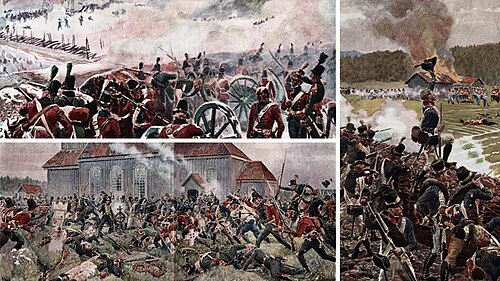
Image licensed under CC BY-SA 4.0? by Imonoz
25th April 🗓️ : Holiday - Christian feast day: Maughold
"Maughold (also known as Macaille, Maccaldus, Machalus, Machaoi, Machella, Maghor, Mawgan, Maccul, Macc Cuill; died c. 488 AD) is venerated as the patron saint of the Isle of Man. Tradition states that he was an Irish prince and captain of a band of freebooters who was converted to Christianity by..."
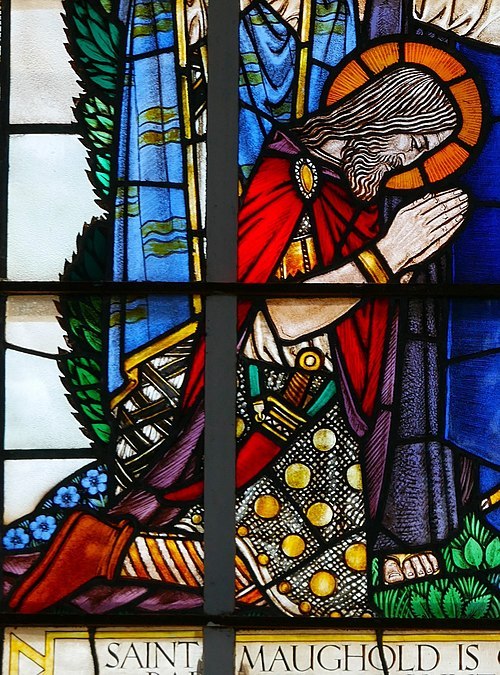
Image licensed under CC0? by Culture Vannin
0 notes
Text
1.1. Los prisioneros franceses: antecedentes
Cuando estallaron las hostilidades entre España y Francia, después de los sucesos del 2 de mayo de 1808 en Madrid, la escuadra

francesa se encontraba en Cádiz unida a la española (realmente eran los restos de ambas, tras la derrota en la batalla de Trafalgar). En ese momento estaba de capitán general de Andalucía Francisco Solano que no era partidario de enfrentarse a los franceses.

El pueblo de Cádiz ante la pasividad de sus gobernantes, se sublevó, derribaron a cañonazos las puertas de la residencia de Solano y finalmente el 30 de mayo lo mataron. Este fue sustituido por el gobernador de la plaza, Tomás de Morla, y se estableció en Cádiz una Junta dependiente de la Suprema de Sevilla, que juró fidelidad a Fernando vii, declarando la guerra a Napoleón, mientras tanto se entablaron negociaciones con la escuadra inglesa que bloqueaba el puerto. La escuadra francesa, intentó ganar tiempo en espera de la llegada de sus tropas, e introdujo sus barcos en el canal de la Carraca, Morla, temiendo un final trágico como el de Solano, bombardeó la escuadra francesa desde las baterías del Trocadero, en la que sería conocida como la Batalla de la Poza de Santa Isabel. Finalmente el 14 de junio, el general Rosilly, que mandaba la escuadra francesa, se rindió ante la española.

Paralelamente, el 19 de julio de 1808, tiene lugar la Batalla de Bailén (fue la primera derrota en batalla campal del ejército napoleónico) que enfrentó a los veintiún mil soldados franceses al mando del general Dupont, con el más numeroso ejército español (unos veintisiete mil) a las órdenes del general Castaños. Tras la derrota del ejército galo, aproximadamente diecisiete mil seiscientos soldados franceses depusieron las armas ese día y aunque las condiciones de la rendición fueron clementes, incluyendo la repatriación de las tropas francesas a Francia, sin embargo, estas condiciones no se cumplieron nunca y aunque el general Dupont y sus oficiales fueron enviados a Francia, el grueso del ejército francés fue hecho prisionero y trasladado a Cádiz.Esa enorme cantidad de prisioneros franceses procedentes de las batallas de La Poza de Santa Isabel y Bailén, fueron recluidos inicialmente en las poblaciones de la Bahía de Cádiz: Rota, Puerto de Santa María y San Fernando para pasar finalmente a los Pontones[1] de Cádiz, prisiones flotantes, donde durante dos años (1808-1810) sufrirían un verdadero calvario. La malnutrición, la falta de higiene y sobre todo el hacinamiento en los pontones (se llegó a recluir hasta 800 franceses en una embarcación de solo 65 metros de eslora por 15 de manga y varios puentes), fueron las causas principales del contagio de enfermedades como la disentería y el escorbuto, llegando a producirse hasta 20 defunciones diarias. Precisamente, el riesgo de contagio de enfermedades a la población de Cádiz fue lo que propició la distribución de los prisioneros franceses por Inglaterra, Portugal, Baleares y Canarias.
General Morla
El 29 de junio, el general Morla, gobernador de la plaza de Cádiz, se dirige al comandante general de las islas Canarias, Fernando Cagigal para que colabore en la custodia de los numerosos prisioneros franceses, preguntándole cuántos puede acoger. La detención de Cagigal y el nombramiento de O´Donnell como nuevo comandante general de las islas Canarias,retrasa la respuesta hasta el 10 de julio, admitiendo recibir 1200 prisioneros.
Después de numerosas vicisitudes, el 11 de mayo de 1809, llega a Santa Cruz de Tenerife, un convoy con 1484 prisioneros franceses. La Junta Suprema de Canarias, establece, ese mismo día, que se trasladara los prisioneros a Candelaria.
El primero de junio se enviaron cuatrocientos noventa y seis franceses a Gran Canaria y al día siguiente se distribuyeron los restantes por toda la isla de Tenerife. Sería exagerado decir que la orden de la Junta Suprema de distribuir los prisioneros por los diferentes pueblos de la isla de Tenerife fue recibida con entusiasmo, así en Icod, la Junta escucha una queja de doña Antonia Cáceres, al tener que ceder su casa para alojar a los franceses. En Los Realejos, los vecinos de las clases menos favorecidas que se ven obligados a vigilar a los prisioneros, sin poder ir a trabajar, para simplificar el problema, sencillamente proponían…. matar a los presos.
El 25 de mayo de 1810 llegaría a Santa Cruz de Tenerife, una segunda expedición con ochocientos prisioneros franceses, de los cuales se enviaron a La Palma doscientos, llegando a dicha isla el día 29 de junio de 1810. Entre ambas expediciones llegarían a Canarias, procedentes de la escuadra francesa rendida en Cádiz, y de las batallas de Bailén y de la Poza de Santa Isabel, dos mil doscientos ochenta y cuatro prisioneros.
En un principio se pensó en recluir, a los doscientos Casa propiedad de Dña. Mencía Vandaleprisioneros enviados a La Palma, en el pago de Argual, en Los Llanos, por su buen clima, abundancia de agua, presencia de soldados para custodiarlos y además tener un cirujano allí domiciliado, pero al final fueron recluidos en unas casas propiedad de doña Mencía Vandale, en la calle San José de Santa Cruz de La Palma, «por tener agua dentro, sufrir menos guardias, y hallarse en una altura que las ventila el aire para evitar contagios y otros perjuicios»[2]. Allí se dispuso una guardia de soldados de milicias, mandados por un oficial.
Sin embargo, el abastecimiento de agua a los prisioneros es uno de los problemas que se presentan a las autoridades palmeras[3], «por robarla los dueños de las huertas situadas por arriba de la prisión y por hallarse deteriorados y arruinados los acueductos y canales que conducen las aguas desde la Madre a esta ciudad para el abasto público».
Además surge otro problema consecuencia de la llegada de ocho prisioneros enfermos de escorbuto, el gobernador militar de La Palma se dirigió a la Junta de Beneficencia para que estos fueran tratados en el Hospital de Nuestra Señora de los Dolores, dependiente del cabildo. La Junta de Beneficencia se negó a tal pretensión al considerar: «los gravísimos e invencibles inconvenientes que esto trae consigo, así considerando por la incapacidad y disposición de esta casa, método en que se sirve y asiste a los enfermos, roce de mujeres, etc.». No obstante la Junta acordó[4] asistir provisionalmente a los enfermos, D. Manuel Díaz Hernández, párroconombrando al sacerdote don Manuel Díaz, miembro de la Junta, como encargado de actuar en este asunto, librando la cantidad de cien pesos corrientes, para lo más urgente.
Seguramente se podría considerar “afortunados” a los prisioneros franceses por el nombramiento del “cura Díaz” como responsable de su cuidado, que aprendió su idioma para poder relacionarse con los detenidos y confeccionó un listado de los 200 prisioneros que se conserva actualmente entre los fondos de la Real Sociedad Económica de Amigos del País de La Palma. Don Manuel, además de párroco de la iglesia de El Salvador, era pintor, escultor, músico, de ideología liberal, y gran orador. Había destacado en defensa de la “Vacuna” que llegó a La Palma en 1804, e incluso se dice que inoculó a los niños con sus propias manos, seguramente estos hechos debieron pesar en su designación por parte de la Junta de Beneficencia como responsable de los prisioneros.
Los prisioneros disfrutaban de régimen abierto, debiendo regresar a prisión por la noche, excepto aquellos que trabajaban para algún palmero que podían dormir en casa de sus amos. Debido a este régimen abierto, varios prisioneros crean algunos problemas, como relata el regidor Juan Nepomuceno Massieu y Salgado[5]: «la misma víspera de Pascua a la noche se encontraron borrachos a varios prisioneros franceses por las calles» y cree que estos excesos no son cometidos por los que están acomodados pues sus amos velan por ellos.
El mismo regidor, Juan Nepomuceno: «hace presente a la Sala haber llegado a su noticia que un prisionero francés ha vendido carne de burro por vaca, y aún se le ha dicho que otro ha vendido carne de perro por carnero»[6].
A partir del mes de abril de 1811, los cautivos empezaron a licenciarse y a trabajar para algún ciudadano palmero, la mayoría como sirvientes, otros ejerciendo el oficio que practicaban en su país de origen, teniendo conocimiento de sesenta y un prisioneros que se licencian hasta septiembre de 1811 (ver lista en el Apéndice), sirva como ejemplo el relato de José María de Franchy Alfaro y Poggio que en su diario de efemérides de La Palma nos dice: «aquí entramos a servir y se llama Santiago María (Jacob Marieux) y empesó a dormir el 27 de junio pues ya desde mayo estaba trabajando y sirviendo en casa, este año de 1811 el 7 de julio lo despidieron»[7]. En dicho periodo tres prisioneros son remitidos a Santa Cruz de Tenerife, seguramente por cometer algún delito o falta grave[8].
Según lo pactado el ayuntamiento sólo tenía que aportar el alojamiento, corriendo la manutención a cargo del comandante general de esta provincia, y como quiera que este no cumplió lo prometido, fue el cabildo el que lo hizo, hasta agotar sus fondos.
Dado que en los primeros años de cautiverio el Comandante general de Canarias había autorizado algunos matrimonios entre mujeres canarias y dichos prisioneros, con fecha de 8 de junio de 1812, el Provisor y Vicario General del Obispado de Canarias pide instrucciones al Consejo del Reino, para conducirse en la determinación de los expedientes que tiene pendientes en su juzgado, con motivo de solicitar contraer matrimonio con naturales de Las Islas Canarias, por parte de los prisioneros confinados en ellas.
A su vez, el Consejo del Reino, el 22 de junio de
1812 pide al Consejo de Estado su dictamen, alegando este las dificultades que tienen los prisioneros para acreditar que son católicos y solteros dada la falta de comunicación con sus lugares de origen debido a la guerra con Francia,
no siendo suficiente el testimonio de unos a otros, que son los argumentos esgrimidos por el Provisor, pero además añade de su propia cosecha la Comisión del Consejo de Estado: «es imposible justificar, de un modo que satisfaga el buen juicio, ni cual sea la creencia religiosa de aquellos prisioneros, gente colecticia de la mayor parte de las naciones de Europa donde, o se profesan o se toleran las muchas sectas del cristianismo, y otras religiones; ni los permisos de sus respectivos padres, ni su libertad de estado, o conyugal». Y posteriormente añade: «mañana vendría un canje, y las mujeres quedarían perdidas y abandonadas, y si subsistiesen en el país, infectas las familias de ideas y opiniones y otros vicios que a la causa pública pudieran ser muy perjudiciales….. Porque el actual gobierno francés, ya desde los principios de su revolución se propuso introducir y extender por todas partes, si fuese posible, su color de felicidad y otras voces tan dulces y lisonjeras como esta, sus máximas destructoras de los gobiernos legítimos, y en lugar de estos subrogar su dominación y su imperio…. Llegase a esto: que los franceses pusieron más de una vez sus miras en dominar las Canarias: de lo cual dan testimonio nuestras crónicas y las suyas. Y la experiencia de que cosas al parecer pequeñas y sin consecuencia, suelen venir a ser ocasión de grandes males, debieron detener al Comandante general y moverle a reusar la licencia, que, sin reparar en los inconvenientes que podría haber, y sin consultar al Gobierno, concedió a los prisioneros de aquella nación para enlazarse con naturales de aquel país: licencia que allí podría ser más que en otra provincia perjudicial al Estado por la consideración insinuada».
«Por donde entiende la Comisión: que el Provisor no debe acceder a dar las licencias que aquellos u otros prisioneros solicitan, o soliciten en adelante; y que fue para circunspección en el Comandante general autorizar con la suya tales enlaces, que se deben evitar. El Consejo, siendo servido, lo podría así consultar a la Regencia, o como fuere más acertado. Cádiz 27 de julio de 1812». Suponemos que el Gobierno aceptó el dictamen del Consejo de Estado y prohibió los matrimonios entre mujeres canarias y los prisioneros franceses hasta que se firmó la Paz y fueron repatriados la mayoría de los reos en 1814[9].
Suerte tuvieron las autoridades locales, que todos los prisioneros tuvieran su profesión, arte u oficio, pues después de pasar muchas penalidades, y antes de que pasaran hambre los reos, las autoridades decidieron ponerlos en libertad, teniendo a la ciudad y los pueblos de la isla por cárcel. Se les vio tan entregados al trabajo, y tanta fue la protección que se les dispensó en el país, y en tanta estima se tuvieron sus industrias, que una vez firmada la paz con Francia en 1814, y puestos en libertad para retornar a su tierra, la mayoría decidió permanecer en La Palma, su segunda patria, en donde crearon honesta y honradamente sus familias, de las cuales hoy descienden algunos estimados paisanos nuestros.
Entre los oficios de los prisioneros, que se casan en La Palma,Oficios de los prisioneros franceses podemos destacar el de latonero, que practicaban Alberto Delcourt y José Bossio, ambos compraron casa en la Calle Real, Delcourt envió a su hijo a estudiar medicina a la Sorbona, ejerciendo de médico en La Laguna, el hijo de Bossio estudió derecho y después de un corto periodo de tiempo ejerciendo en La Palma se trasladó a Cuba. Louis Lovison y Pedro Salel trabajan de panaderos en Los Llanos de Aridane y figuran en un censo como únicos extranjeros….
En el pueblo de Los Llanos con fecha 15 de marzo de 1819 el Sr Alcalde Real don Manuel Pérez Wangüemert solicita lista de los ciudadanos extranjeros que se hallan en este pueblo y sus distritos que solamente hay dos Pedro Salel de 32 años natural de Uzeis, en la provincia de Languedoc de nación francesa, llegó a esta isla el 29-6-1809, de profesión panadero, casado en este pueblo y otro llamado Luisón Segundo, de Callianiti provincia de Piamonte, de nación italiana, casado en este pueblo y de profesión panader. Juran conservar la religión católica y guardar fidelidad a ella y al Rey nuestro señor y quieren ser sus vasallos sujetándose a las leyes y prácticas de estos Reynos, renunciando a todo fuero de extranjería y a toda relación, unión y dependencia del país en que nacieron y prometen no usar de la protección de él, ni de su embajador, ministro o cónsul, todo bajo pena de galeras, presidio o expulsión absoluta de estos Reynos y confiscación de sus bienes, firman Manuel Pérez Wangüemert alcalde, Lorenzo de Justa, fiel de fecha, José Medina, cartulario.
1.2. Vicisitudes de los prisioneros franceses en Canarias
Se sabe que ya se habían producido fugas cuando estaban prisioneros en los pontones de Cádiz. En Canarias están documentadas cinco evasiones, aunque pudieron ser más, con un total de doscientos cincuenta y seis presos evadidos.
A finales de 1809, cuatro prisioneros franceses intentaron apoderarse del barco de Gabazo, que pertenecía a la matrícula de Tenerife.
El 4 de febrero de 1810, quince prisioneros se evadieron en el bergantín inglés Endeavour, desde el puerto de Santa Cruz de Tenerife, rumbo a Gran Canaria, anclando en Arguineguín para hacer aguada y tomaron rumbo a Senegal, donde fueron capturados por una fragata inglesa y enviados a Londres.
En el puerto de San Marcos de Icod, en 1812, doce reclusos franceses, capturaron a la tripulación de un bergantín inglés, pero al desconocer la maniobra de salida del puerto se frustró la fuga inmediatamente.
El día 14 de octubre de 1814 se fugan en Mazo[10], La Palma, por la Caleta de El Palo, en una barca de pesca, los prisioneros: Pedro Martin, Armand Lussac, Pedro Amalbert, y Bernard Tissier, para pasar luego al bergantín Antenor que salió de Santa Cruz de La Palma rumbo a La Habana.Partida de bautismo de Simon Garnier en Is sur Tille (Borgoña)
Tres prisioneros de guerra franceses evadidos de las islas Canarias fueron capturados en Grainville y dirigidos a Caen (noviembre de 1814).
Tres plagas, se produjeron durante el periodo de cautividad de los prisioneros de guerra franceses en Canarias: la fiebre amarilla, la langosta y el hambre.
La fiebre amarilla llegó a Santa Cruz de Tenerife el 11 de septiembre de 1810, en barcos procedentes de Cádiz. Durante la epidemia, los prisioneros franceses tuvieron un comportamiento ejemplar, guardando las casas de gente que había huido hacia el interior de la isla, cuidando a los enfermos, y llevando al cementerio a los fallecidos. Grande y hermosa recompensa a la hospitalidad recibida según el escritor canario Domingo J. Navarro. Debido a estas obras de misericordia fallecieron doscientos prisioneros franceses. Ni la isla de La Palma, ni tampoco las islas menores se vieron afectadas por la fiebre amarilla. ¿Podríamos considerar afortunados a los prisioneros franceses de la isla de La Palma y de las islas menores, por no afectar la fiebre amarilla a las mismas? Seguramente no se trata de suerte, sino de la eficaz labor de las autoridades sanitarias impidiendo la llegada de barcos procedentes de las islas “mayores”.
En el verano de 1812, arribó a Canarias una plaga de cigarra, ayudando los prisioneros franceses en las labores de erradicación de la langosta.
Como consecuencia de los dos años de fiebre amarilla, y la posterior llegada de la langosta, a continuación llegó "el hambre", el pueblo se nutría de raíces, arroz y harina de cazabe traída de África. Durante estas fechas, patriotas de Santa Cruz de Tenerife que con gran desprendimiento pusieron sus caudales a disposición del Municipio, evitaron una catástrofe mayor, destacando el alférez mayor del cabildo que compró de su bolsillo dos mil fanegas de trigo, vendiéndolo luego por debajo del precio de costo[11].
Sin embargo, el pueblo de Tenerife estaba enfurecido ante el pago de medio diezmo que instituyó la Junta Suprema para sufragar la guerra con Francia, y en La Orotava, lugar de residencia de los nobles descendientes de los antiguos conquistadores, da lugar a que la plebe se rebele contra esta clase alta que el vulgo denomina «caballeros», siendo la víctima propiciatoria un maestro de baile de origen francés monsieur Pierre ó mosiu Perico, que es detenido. El pueblo sublevado baja al Puerto de la Cruz, y allí serían sus víctimas el comerciante Joseph Bressnan, y el músico Louis-Bertrand Broual que fueron asesinados por la plebe. Cuando en 1812 fueron juzgados los sublevados, condenados a penas de cinco, ocho, ó diez años, muchos habían fallecido y otros liberados. Para la opinión pública supuso una gran decepción el no ver ahorcado a ninguno de estos bandidos, de lo cual se queja amargamente Geisendorf[12].
1.3. La repatriación
El 24 de abril de 1814, los Borbones volvían al trono de Francia y Luis xvii desembarcaba en Calais. Por el convenio de Madrid, de 25 de mayo de 1814, se aprueba la repatriación de los prisioneros franceses confinados en Portugal, Canarias y Baleares. De los 2284 franceses llegados en 1809 (mil cuatrocientos ochenta y cuatro) y 1810 (ochocientos), doscientos cincuenta y seis se evadieron, quinientos veinticuatro fallecieron (en una proporción similar a la población canaria), quinientos diecisiete se quedaron en las islas y tan solo novecientos ochenta y siete fueron repatriados.
Partida de enterramiento de Simon Garnier en los Sauces
Para orgullo del pueblo canario, de los dos mil doscientos ochenta y cuatro prisioneros enviados a nuestro archipiélago, fallecieron quinientos veinticuatro (23%) por las tres plagas y causas naturales, en igual proporción que fue mermada la población autóctona.
Sin embargo, de los trece mil deportados a Baleares sólo sobrevivieron tres mil quinientos (73% de mortalidad), tras ser abandonados prácticamente en la isla desierta de Cabrera.
Sin lugar a dudas, los presos más afortunados fueron los enviados a las Islas Canarias, da fe de ello el alto número de prisioneros que se quedaron en las islas para formar familias esposándose con mujeres Canarias[13]
Con respecto a los quinientos diecisiete prisioneros que permanecieron en Canarias, el Cónsul de Francia dice que, entre ellos no hay ricos comerciantes ni personas pudientes, sino, artesanos, sirvientes, la mayoría pobres y con numerosos hijos.
Por otro lado, Geisendorf dice: «hay que creer que los argumentos persuasivos del Ministro del Rey Francia, no tuvieron efecto sobre aquellos que les había seducido, el dulce clima de las Islas Canarias, o los ojos aún más dulcesde las canarias»[14]. Entre los quinientos diecisiete prisioneros que fijaron su residencia en Canarias, cuarenta y dos solicitaron en el Obispado de Canarias[15]. Estos juramentos de soltería, necesarios para contraer matrimonio, fueron recopilados por el prestigioso historiador tinerfeño Leopoldo de la Rosa Olivera[16], que nos aporta tres listas, la de los solicitantes de los expedientes de soltería, la de los testigos prisioneros franceses de dichos expedientes de soltería y la Matrícula de extranjeros del Ayuntamiento de La Laguna.
2. Los prisioneros de La Palma
Hemos encontrado diecisiete prisioneros franceses que se casan en la parroquia de El Salvador de Santa Cruz de La Palma, cinco que lo hacen en los Remedios de Los Llanos de Aridane, uno en San Blas de Mazo, otro en San José de Breña Baja, y aún nos falta el matrimonio de uno de los prisioneros solicitantes de expedientes de soltería en La Palma. En total veinticinco prisioneros franceses se casan en La Palma.
Los nombres franceses fueron castellanizados, adaptándolos a algún apellido ya existente en Canarias como es el caso de Francisco Borges que pudiera ser François Bon de la lista de prisioneros franceses perteneciente a la Real Sociedad de Amigos del País (atribuida a Manuel Díaz[17], párroco de El Salvador, que aprendió el idioma, para poder impartir la confesión), ese es también el caso de Avigné que en los archivos parroquiales se inscribe como Viña. En otros casos como es el del apellido francés Pommerole se registra como Pombrol. Algo parecido sucede con Simon Grenier,En Is sur Tille (Borgoña) con los actuales Garnier. de la lista de prisioneros franceses de La Palma[18], que en el «expediente de soltería» se inscribe como Garñiel, sus hijos como Garaniel, y las siguientes generaciones como Garniel y por último Garnier.
En varias ocasiones los descendientes de los prisioneros franceses han intentado ocultar el motivo de la llegada de estos a las islas, como el caso de Garnier que se nos presenta como víctima de un naufragio, y en el de Delcourt, un bisnieto[19] suyo dice que viajaba desde Flandes a América, le gustó La Palma y después de hacerle un hijo a Doña Manuela Toledo se casó con ella. Y en el caso de Juan Arzol: "el primer Arzol que llegó a La Palma, envuelto en la leyenda, dicen que fue un pirata.....[20]"
Como habíamos apuntado anteriormente a los prisioneros franceses se les prohíbe casarse con mujeres canarias, hasta que firmada la paz con Francia, se pone en libertad a los que quisieron quedarse en nuestras islas, celebrándose el primer matrimonio en La Palma el 30 de abril de 1815.
DEFUNCIONES
Tres son los prisioneros franceses fallecidos en La Palma en cautividad (1810-1814): Juan Martín, de nación francesa, soltero, fallecido[21] en Santa Cruz de La Palma, el día 18 de noviembre de 1812, “uno de los franceses que vinieron de esta, criado del médico Don José Rodríguez, no se sabe sus padres, ni edad”. Prisionero número 96, soldado de la Quinta Legión.
Junto a Miguel Lamasse, fallecido el día 19 de diciembre de 1810 y Juan Bricón que murió tísico el 19 de agosto 1811, son los únicos prisioneros franceses de los que tenemos constancia que fallecieron en “cautiverio”, es decir antes de firmarse la paz en 1814.
Conclusiones
Los prisioneros capturados al ejército francés durante la Guerra de la Independencia que, llegaron a La Palma en 1810, mayoritariamente eran franceses, pero también de otras nacionalidades, italianos, alemanes, o flamencos, etc., y al menos unos cuarenta permanecían en La Palma, un año después de la repatriación, al terminar la guerra en 1814.
De la información obtenida en los expedientes de soltería, se deduce que la mayor parte fueron apresados en Bailén y conducidos a los Pontones de Cádiz, pero unos llegaron a la península caminando desde Italia, y otros desde Francia (Bayona), por Vitoria. De los catorce marinos que figuran en la lista de prisioneros no tenemos más documentación, suponiendo que pertenecían a la escuadra francesa rendida en Cádiz, y que abandonaron la isla al firmarse la paz en 1814.
Del listado de prisioneros solicitantes de expedientes de soltería elaborada por Leopoldo de la Rosa Olivera, aún no hemos encontrado los de Juan Pedro Garriga, y Bernardo Viña, pero sin embargo, hallamos seis expedientes que no están en la lista de De la Rosa: Nicolás Bernard, Maturino Martín, Felipe Montpelier, Pablo Sliner, Francisco Borges, y Pedro Pagés.
Por último, de los veinticinco prisioneros hallados en los libros de matrimonios de La Palma, seis no están en la lista de solicitantes de expedientes de soltería, ni se encuentra su expediente en el obispado: Juan Antonio Compagnier, Albert Delcourt, José Bautista Bailly, Pedro Salel, Juan Faure, Bartolomé Rosa. Cabe suponer que si en La Palma hemos detectado expedientes de soltería, que no figuran en el trabajo de Leopoldo de La Rosa, algo parecido puede que ocurra con los de Tenerife, y que sean muchos más de los treinta y uno (de Tenerife) que figuran en la lista de solicitantes de expedientes de soltería, los que realmente se encuentren en el archivo del obispado. Convendría pues revisar la investigación de Leopoldo de la Rosa Olivera, ampliando esta a la provincia de Las Palmas.Benito López Garnier y familia
Las investigaciones genealógicas podrían parecer egocéntricas, dado que conocer nuestro lugar de procedencia, justificado por la sangre, nos afirma en la pertenencia a un grupo, un pueblo, una sociedad, pero a medida que profundizamos en su estudio nos damos cuenta rápidamente de la diversidad de nuestros orígenes: ninguno de nosotros proviene de un único lugar geográfico ni de una única clase social, y como diría Louis-
Sébastien Mercier[22]: «¡Si el Cielo nos descubriera de golpe, la verdadera filiación de las genealogías humanas, veríamos un espectáculo nuevo y curioso! No habría rey que no contara con un esclavo entre sus parientes, ni un esclavo que no contara con un rey».
La genealogía facilita la comprensión de la diferencia y resulta muy útil en la lucha contra el racismo.
1 note
·
View note
Text
Curso online com certificado! O Ensino da língua inglesa no contexto da educação brasileira
O ensino de língua inglesa como disciplina obrigatória no currículo escolar brasileiro teve início em 1809. Dom João VI decretara a implantação do ensino de duas línguas estrangeiras, a inglesa e a francesa, escolhidas estrategicamente, visando às relações comerciais que Portugal mantinha com a Inglaterra e a França. Assim sendo, a função do ensino era, […]
0 notes
Note
Have you seen the Sharpe tv series? It’s about the Napoleonic Wars (it happened during Henry’s from forever life) Now I am imagining a forever abc and Sharpe crossover where Sharpe meets Henry as they are posted in Portugal 1809. Henry is a doctor posted on the front line so he can treat injured and sick soldiers.
Hello there, Anon. Unfortunately, no, I haven't seen the Sharpe TV series, sorry. I had never heard of it actually. Google tells me it's a British show from the 90's, with Sean Bean.
Here is the thing: I'm French. And funnily enough, British shows telling tales of the Napoleonic Wars from the British side aren't very popular on this side of the Channel...
Hornblower was never shown on French TV either. I watched it a couple years ago, because I fell in love with Ioan Gruffudd, but as much as I do enjoy Ioan's adorable smile and glorious curls, the anti-French feeling gets annoying (and it is even worse in the books).

1 note
·
View note